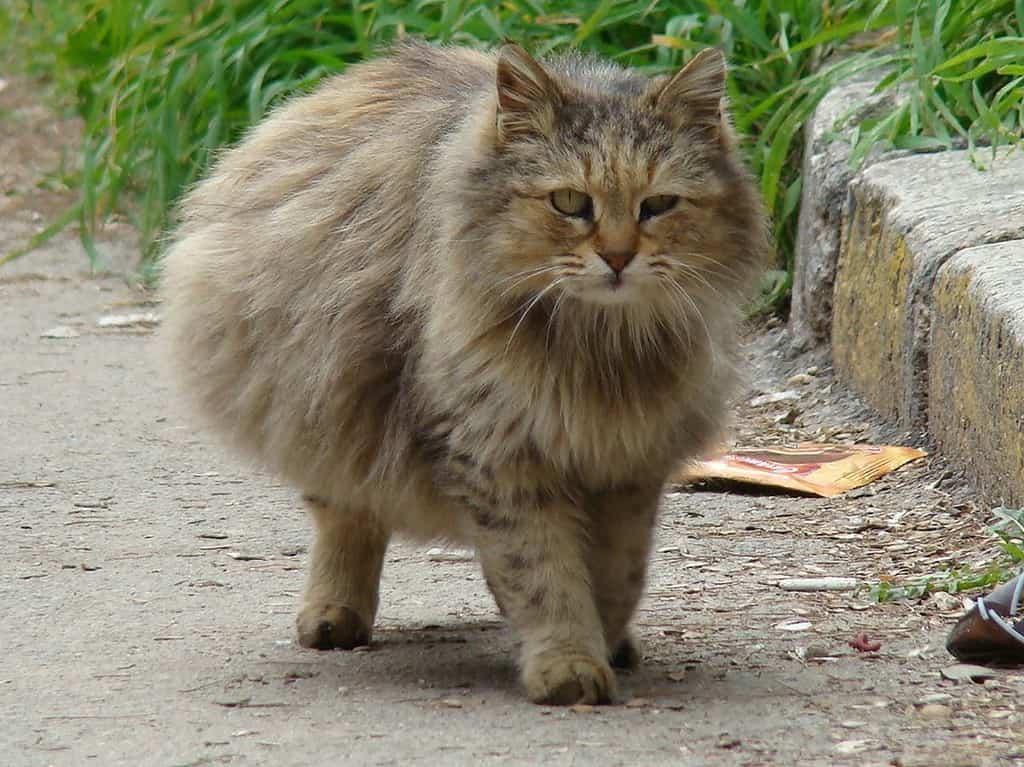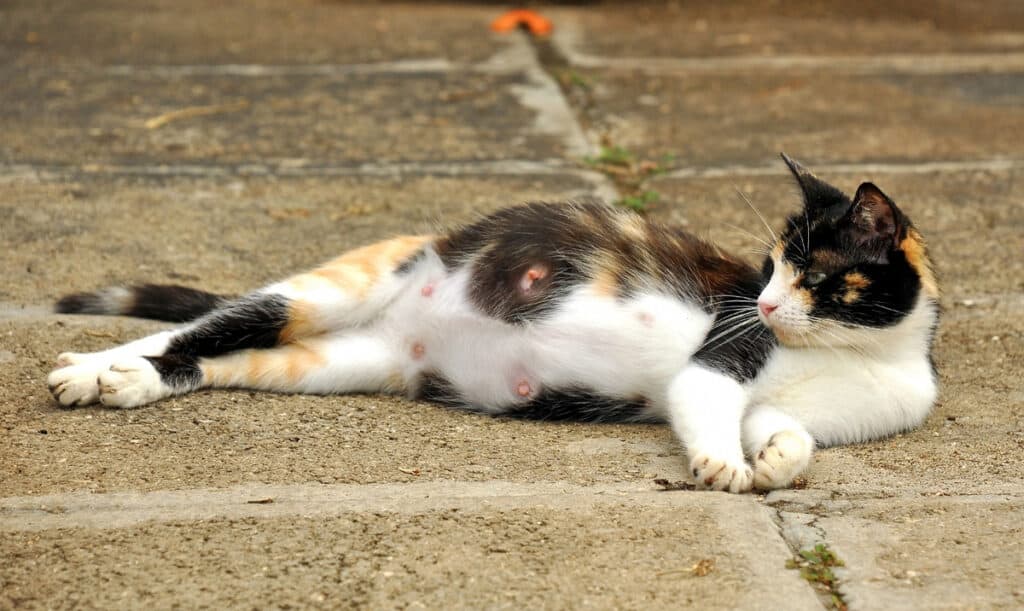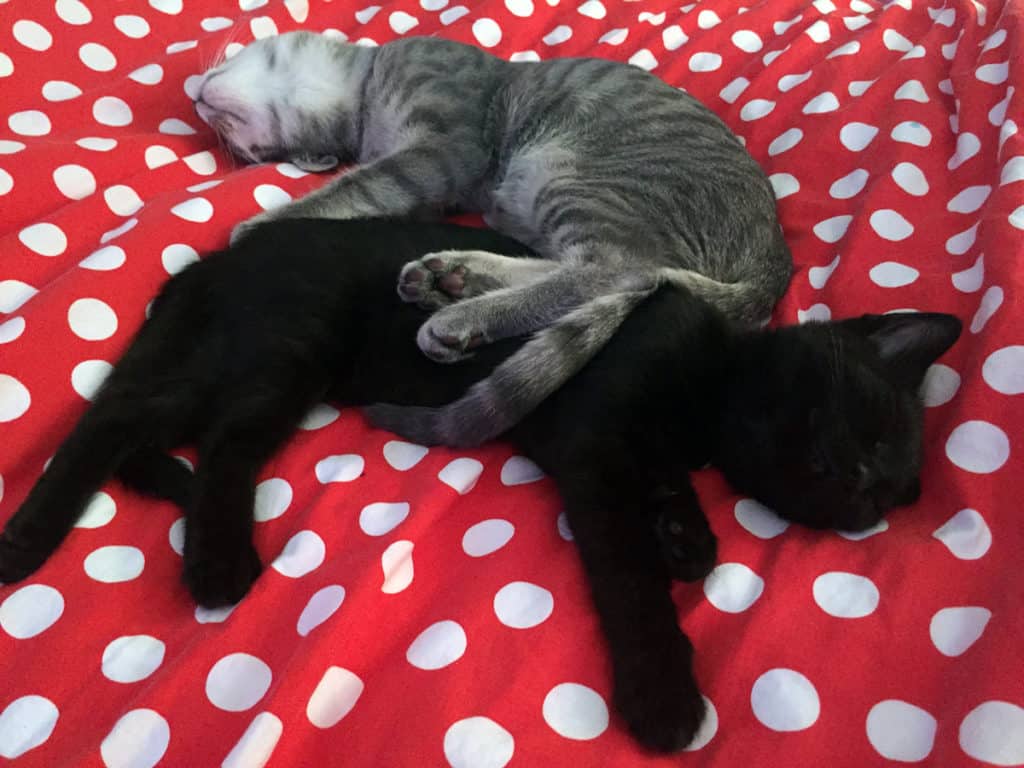A female cat who hasn’t been spayed is known as a queen. The female domestic cat can start reproducing as young as four to five months old.
Fertility cycle in a cat
When a female cat is ready to reproduce, they go into heat.
A cat’s fertility cycle, also known as the estrous cycle, consists of several stages: proestrus, estrus, interestrus (or interestrus), and anestrus.
Here’s a breakdown of each stage:
- Proestrus: This is the period leading up to heat, and it usually lasts one or two days. The female cat, or queen, may become more affectionate, especially towards male cats, and her vulva may swell slightly. However, she will not yet accept a male cat for mating.
- Estrus: This is the stage commonly referred to as being “in heat”. It lasts for around four to six days if the queen mates, but it can last longer if she doesn’t. During this time, she’ll be very vocal, often with loud and frequent yowling. She’ll also exhibit behaviors such as increased affection, rolling on the floor, and raising her hindquarters. Most importantly, this is the stage when she will accept a male cat for mating.
- Interestrus (or Interestrus): If the queen did not mate during estrus, she’ll enter the interestrus stage, a period of non-receptivity lasting about one to two weeks before the next cycle begins.
- Anestrus: This is the period of sexual inactivity during the late fall and winter months when the days are shorter. The queen’s reproductive system essentially goes into a rest period until the arrival of the next breeding season.
How Often Can Cats Go Into Heat?
Cats are seasonally polyestrous, which means they have multiple estrus cycles during certain times of the year, usually in warmer months. A queen’s cycle is influenced by several factors, including day length, temperature, and presence of intact male cats (known as toms or tomcats).
When do cats go into heat?
The breeding season varies geographically and according to environmental conditions like as temperature and daylight hours.
For example, female cats in the Northern Hemisphere typically go into heat from January to late September. Cats that live in more tropical locations or that spend the most of their time indoors, on the other hand, may cycle all year.
How long do cats stay in heat?
The heat cycle, also known as the estrous cycle, lasts on average six days.
What are signs that a cat is heat?
The most obvious signs that a female cat is in heat are behavioral. Female cats in heat will become a lot more affectionate and demanding of attention. Rolling and rubbing on the ground and objects is common. Female cats will also walk around and tread their hind legs.
Female cats in heat will also become more vocal. Caterwauling, yowling, and excessive purring are commons sounds a cat in heat will make to attractive male suitors.
Cats are induced ovulators
Cats are induced ovulators, which means that breeding triggers the ovaries to release eggs. If a female cat in heat mates with a male, the stimulation induces ovulation usually within 27 hours of mating.
How long are cats pregnant?
Cats, specifically domestic ones, typically have a gestation period of approximately 63 to 67 days, although it can range from 61 to 72 days. It’s important to note that variations can occur, and the exact length of pregnancy can depend on factors such as the breed of the cat and her overall health.

If a cat is pregnant for longer than 72 days, it’s recommended to seek veterinary advice as this could potentially indicate a problem with the pregnancy. Similarly, if a cat gives birth to kittens before 61 days of gestation, the kittens may be premature and may require special care to survive.
Signs a cat is pregnant
During the first few weeks of gestation, the queen may not exhibit noticeable signs of pregnancy. The first sign is using a “pinking” of her nipples. At around three weeks, the fur around the nipples may also start to fall out, making the teats more visible to the impending kittens.
Cats can also experience “morning sickness” due to surging and changing hormones usually starting around 4 weeks. Female cats may have a reduced appetite, vomiting, and fatigue during those weeks. The appetite in a pregnant cat usually rebounds around six weeks into the gestational period.
As the cat’s pregnancy progress, she will gain weight and her appetite will increase. Pregnant cats will eat about 1.5 times more food that normal. Pregnant cats will also drink a lot more water than typical.
Nesting period
During the last couple of weeks of a cat’s pregnancy, she will start to nest. This means preparing for a hidden, safe, and comfortable place to give birth.
Having a safe, dark, and dry place is especially important for cats that given birth outdoors. Kittens when they are first born are blind, deaf, and mostly immobile and are vulnerable to predation.
By the last few weeks of pregnancy, the queen’s abdomen will have visibly expanded to accommodate the growing kittens. During this time, it’s crucial to provide a nutritious diet to support both the queen and her kittens. A vet may recommend a diet specially formulated for pregnant or nursing cats, which is higher in certain nutrients.
During the final week of pregnancy, the cat’s mammary glands will grow in size. Two days before the cat gives birth, her mammary glands will start to produce milk.

When birth is imminent, the cat will start to pant, meow, and become restless. The cat will frequently groom around the birth canal and nipples. Some believe newborn kittens will follow this scent trail to access their mother’s milk.
Birthing process in cats
A cat’s temperature will drop about one ºC when labor starts.
The birth process, known as queening, can last anywhere from a few hours to a day. The queen will typically birth a kitten every 30 to 60 minutes until all kittens are delivered.
Litter of kittens
A female cat will give birth to as little as one kitten or as many as nine kittens at one time. The average size of a litter is between 4 to 6 kittens.
These kittens can have different fathers. Female cats can mate with multiple partners while they are in heat.
A group of kittens is known as a kindle. More: 9 Things to Know About Kittens

Female Cats Can Become Pregnant Again After Giving Birth
Female cats can go into heat about six weeks after giving birth.






